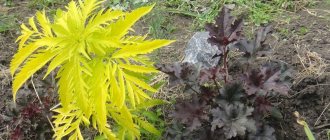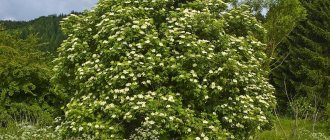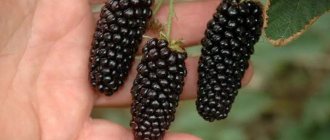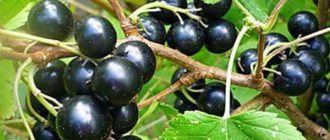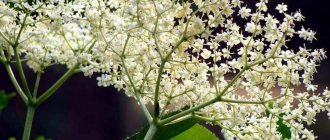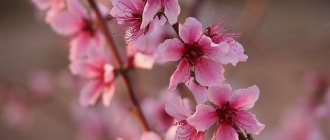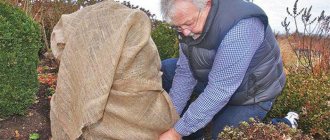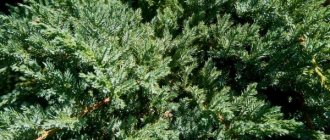Varietal characteristics of the crop
The second name for elderberry is Eve. The deciduous shrub grows vertically and has a large, wide crown. Initially, it was cultivated in Europe, the Caucasus, and Asia Minor. But thanks to the work of breeders, the plant can be planted against the walls of a house, on a slope. Before starting planting activities, it is worth studying the varietal specifics of the crop:
- the foliage has a bright purple hue, openwork. The leaves are arranged oppositely, bloom in early spring and fade in late autumn. The color remains for the entire growing season;
- milky pink flowers appear in spring, late May or early June. In autumn, in August or September, they are replaced by red round fruits;
- high growth - about 2.5 m. Over the course of a year, the elderberry stretches 50 cm and grows in width by 15 cm;
- prefers deep, moderately dry, loamy or clayey soils rich in humus;
- The branches are thick, light gray in color. The lignified material is gray in color, covered with cracks, and feels like cork;
- the root system is branched and wide;
- frost resistance. The plant is suitable for climate zone class 5A.
Elderberry is distinguished by its undemandingness to insolation and light. It takes root in semi-shaded or sunny areas. The berries are used to make baked goods, juice, wine or jelly.
Application in landscape design
Both specifically bred varieties and wild species are used as ornamental shrubs. It is excellently used as hedges due to the fact that it grows quickly. If it is formed with the help of constant trimmings, it will look neat and attract the eye with its interesting appearance.
Some gardeners distinguish this tree from all other species. It is placed away from other shrubs, suggesting a stunning effect during flowering. If the bush is formed, then black elderberry can be placed not only as a hedge, but also to create mixborders or flower beds with different levels.
In addition, Black Lace elderberry can be used on alpine hills and in areas with evergreens.
Formative pruning is a must. If you follow a simple procedure, an interesting plant with the shape of a ball or a columnar shrub may appear on the site. The main thing is to use your imagination and experiment, especially if the active growth and spreading nature of the exotic tree allows this.
Thus, Black Lace elderberry has an interesting range of leaf colors, spreads an aromatic scent over large areas and does not require specific care. It is actively used for planting in various combinations.
More information can be found in the video:
Reproduction and conditions for cultivation
The Black Lace variety is propagated using seedlings, cuttings, layering and seeds. The maximum height of seedlings for transplanting into the ground should be 50 cm. Keep in mind that when growing seeds, the shrub will lose its varietal characteristics. Cuttings require cutting in the fall or before the sap begins to flow. Chibouks 25 cm long with 1-2 buds are preferred. To form roots, the material is placed in moist soil. After the shoots appear, it can be planted in open ground.
Optimal growing conditions
Black elderberry Black Lace is unpretentious and relatively resistant to frost. In addition to clay soils and loam, it takes root well on nitrogen, sandy, semi-dry or calcareous soils. In order for the plant to take root and produce a good harvest, it is recommended:
- before planting, prepare a soil mixture based on 7-8 kg of rotted leaves, 30-50 g of potassium and 50 g of phosphorus;
- choose a suitable place - illuminated or half-shaded areas;
- place the crop in the ground in April or September;
- control the alkali content in the soil. Good growth of shrubs is observed on slightly alkaline soils.
Young shoots are covered for the winter to prevent freezing of the root system. The plant blooms and bears fruit 3 years after planting.
Order of planting elderberry
Black elderberry seedlings are planted when they have reached the age of 1-2 years. Practical farmers recommend adhering to the following algorithm:
- Select a site for cultivation located in the north or east of the plot.
- Consider which pollinators will grow nearby. For cross-production of pollen, you can plant fruit trees and bushes.
- Planting work should be carried out in warm weather. First, dig a planting hole 50 cm wide and deepen it 50 cm.
- The shrub is placed with its roots down, carefully straightened and dug in to the root collar.
- They install a standard - a wooden peg that does not reach the lower branches.
- After planting, Black Lace is watered. Soil moisture is periodically monitored.
When purchasing elderberry seedlings from a nursery, order the material in a plastic container. Prolongators are usually added to the soil, which accelerate the rooting of the crop. The plant must be planted with container soil.
How does elderberry reproduce?
Elderberry propagation occurs in three ways:
- By layering. Gives the greatest result, and therefore is most often used. It is necessary to bend a young elderberry branch to the ground and sprinkle it with fertile soil. The end of the escape should remain at the top. You can plant it next year when the shoot takes root.
- By cuttings. The most common option. Cuttings must be prepared in advance and rooted before planting.
- Seeds. In order to propagate the shrub by seed, it is necessary to purchase seeds in the store, since those collected from the berries do not retain the characteristics of the variety and the parent plant.
How to properly care for the Black Lace variety?
The beautiful unusual black elderberry of the Black Lace variety, the correct planting of which requires appropriate care, looks spectacular on the site. In order for the shrub to bear fruit and delight you with flowering, do not forget about:
- timely watering, especially on hot days;
- removing weeds, loosening the soil;
- adding mulch to the tree trunk;
- timely feeding from the 3rd year of growth. In the spring, ammonium nitrate (30 g) is applied, after the foliage appears, complex nitrophoska (40-50 g) is planted under the bushes. In the fall you will need organic matter - compost or green manure.
Landing
The site for planting shrubs should be selected based on the future size of the adult plant. It is better to place the elderberry in the sun or in light partial shade, in an area protected from strong winds. In order for the plant to delight with lush flowering and berries, the soil must be nutritious; for a hedge, you can plant a bush on depleted soils. Elderberry does not like acidic and damp soils. The hole for the seedling should be slightly larger than its root system. When planting, you should add 50 g of phosphorus and potassium fertilizers and a bucket of humus.
We recommend that you read the description of black elderberry variety Black Beauty.
The sequence of further actions is as follows:
- Pour a layer of fertile mixture onto the bottom of the hole.
- Place the seedling in the middle of the hole and cover with the rest of the soil.
- Gently compact the soil around the trunk, making sure that the root collar remains above the soil level.
- Water the elderberry and mulch the tree trunk with peat, sawdust or bark.
Both spring and autumn are suitable for planting, and container seedlings can be planted in summer. It is advisable to carry out autumn planting 1–1.5 months before frost, so that rooting has time to occur.
What to do if the bush does not bear fruit?
Black leaf elderberry does not bear fruit if it is planted in the shade. The bush needs to be transplanted to a sunny area. The plant may lack nutrients, so fertilizing is done in the spring. When there is snow, they use ash; in March they begin to add organic matter - manure or compost. Take care of pollinators - plant fruit trees or organize a home apiary.
Growing conditions
For cultivation, you need to choose the optimal place. The eastern side or northern edge of the site is suitable for this. In order for the shrub to be pollinated well and efficiently, it is advisable that other plants blooming during the same period be located nearby.
In most cases, black elderberry is an unpretentious shrub. It grows on various soils and does not require any special care. It can also grow on poor soils, but most of all it prefers limestone and sandy soils, as well as semi-dry mixtures. Does not differentiate between advantages for growing in heavy or medium soil substrates.
The only requirement for good growth and rapid growth is a high content of nitrogen fertilizers in the soil.
It can grow in slightly acidic soil with a pH level of 5.5 to neutral (7.0 pH). The tree loves to be in the direct rays of the sun. She is not affected by ultraviolet radiation, so she is not afraid of burns. The shrub can also be placed in the shade, but then rapid growth is not expected. If the plant receives at least 2-3 hours of direct light, then moderate growth is possible.
Thus, planting the plant in a specific soil with strict adherence to acidity is not required. Elderberry grows quickly, filling the entire space with spreading branches. Therefore, this type of shrub is popularly considered a weed. But at the same time, if you look after it and trim it on time, then its decorative properties will be valued and considered the highlight of the entire garden plot.
Plant pruning sequence
Black Lace should be formed in the form of a multi-stemmed bush. From 12 to 20 branches of various ages are left on it. Berries appear on last year's branches, so it is necessary to ensure the growth of young shoots. Pruning is carried out in spring or autumn according to the following scheme:
- in spring, the upper parts of the branches are reduced by 1 bud, and the branches on the sides - by 2-3;
- old branches are given a ring shape;
- Ornamental shrubs are rejuvenated almost completely once every 3 years. Only stump shoots 10-15 cm long are left.
Decorative molding is performed after frost. Cut off branches “on the stump” contribute to the growth of shoots, density, growth of the bush by 1.5 m and enlargement of foliage. Keep in mind that in the first year after radical pruning, elderberry does not bear fruit or bloom.
Description of the variety
Elderberry grows in the form of a wide shrub up to 2 m high with the same crown diameter. The shape and structure of Black Lace leaves fully corresponds to its name, which translates as “black lace”. Indeed, large leaf plates are dissected into thin long lobes, resembling a lace pattern. And they are painted in a dark cherry, almost black color with a glossy sheen, giving the elderberry bush a special decorative appearance.
Dark-leaved varieties are best planted in the foreground rather than used as background. These types of elderberries go well in group plantings with conifers, spirea, and barberry.
The bush blooms with small pinkish flowers, collected in dense inflorescences-tassels. As flowering fades, the pink tint gives way to cream. What is also characteristic is that they smell amazing, spreading a subtle aroma of lemon. At the beginning of autumn the fruits, red and black berries, ripen. They are edible and suitable for making compote or jam.
The only drawback of the variety is its low resistance to aphids.
Pests, diseases of the Black Lace variety and their control
Plants are not resistant to anthracnose, fusarium, phyllosticosis, powdery mildew, aphids and spider mites. This leads to curling of the foliage, death of the trunk and spoilage of the fruit. Spider mites attack crops during drought, and aphids and May beetles - in spring. The root system is damaged by the cutworm. Several methods are used to combat diseases and insects:
- treatment with fungicidal compounds. Preparations Skor, Ordan, Horus, Switch are sprayed in the fall;
- prevention with insecticides. The plant is treated with Aktara, Match, Aktellik in spring and summer;
- spraying on the trunk (10 cm above the soil) imadacloprid against the cockchafer or cutworm;
- lubricating the root collar and pouring various preparations into the soil according to the instructions.
Prevention of diseases and insects is necessary throughout the growing season. The processing frequency is 40-50 days. Spraying the crown and spilling along the root neck is carried out from April to September at intervals of 1 time every 40 days. From 30 to 100 g are applied under the root of the product, depending on the parameters of the elderberry.
What are the benefits of elderberry?
And to this day there are legends that for a long time people have been eating elderberries and living for a long time thanks to this. Both the berries and flowers of this shrub contain a lot of useful substances.
Important! Elderberries can be eaten only after heat treatment. They taste sweet and sour and contain cyanide. The dose is too small to cause serious harm, but may cause stomach and intestinal upset. The same troubles can follow if you eat too many elderflowers.
Forewarned is forearmed! Now more about the benefits.
Elderberry berries are used as a laxative, diuretic and diaphoretic. They help improve immunity and help fight viruses (they are especially effective against various strains of influenza).
Flowers have found wider use. In addition to the same beneficial properties as berries, they help with cleansing the blood and liver, with sore throats, burns, wounds, diabetes and joint diseases. Used as an antipyretic.
Elderberry berries, flowers and leaves are an excellent source of antioxidants and are also low in calories. For example, the anthocyanins they contain are 3.5 times more effective than vitamin E. A, according to research, diets containing antioxidants can prevent chronic diseases.
We have already found out that elderberries should not be consumed fresh. This means we make compotes from the berries, make preserves and preserves, and also use them for baking pies. We make decoctions from the flowers or simply add them to tea. After heat treatment, both bring only benefits without any discomfort.
By the way, there is also red elderberry (as a separate species). It is found not only in the wild, but also in nature, because it also has several varieties.
It is important to remember that this species is considered poisonous, therefore neither the fruits nor the flowers can be eaten, but this shrub has one useful function.
Its leaves and shoots emit a rather unpleasant odor. Having picked them, they can be placed near mole holes (underground friends will most likely no longer use this exit) or, for example, seedlings can be planted next to a cesspool (the flies will no longer be there).
Reviews from gardeners about black elderberry
Summer residents note that the plant takes root differently in domestic climatic zones. In the Moscow region it practically does not grow, freezes slightly and almost does not bloom. But in Voronezh, on fertile, abundantly irrigated lands, the increase in height and width is 3 m. On favorable soils, trees have thick trunks, which dry out and shoots form on the side. Gardeners report that elderberry has unpredictable branch longevity. The shrub, according to farmers, is resistant to frost and increased groundwater level, but is subject to aphid invasion. Experts note the shading of the plant by tall trees, which causes the foliage to turn green. A similar phenomenon occurs under unfavorable weather conditions. Unusual bright purple foliage will highlight a monochromatic green lawn and complement a monochrome garden. Taking into account the agrospecific characteristics, the unique black elderberry variety Black Lace, the correct planting of which implies timely care and pest prevention, will bear fruit for more than one season.
Article Rating
Description of elderberry Black Lace
It is a deciduous shrub that grows vertically. It reaches a height of 2–10 meters. The branches are dense, but very thin. While the branches are young, they are green in color and in appearance resemble stems more than full-fledged tree branches. The leaves are long and consist of an odd number of individual leaflets.
Elderberry begins to bloom at the end of spring and continues until the end of August. White and light beige inflorescences form on the tree. The inflorescences reach 20 cm in diameter. After flowering, at the end of summer, the berries begin to ripen. These are black, small berries with red flesh and a seed. During flowering, the elderberry develops a strong aroma, which, when found close, even becomes unbearable for some.
Recommended areas for cultivation: Moscow region, North-West and most of Russia, with the exception of Southern and Central Siberia.
Growing conditions
For cultivation, you need to choose the optimal place. The eastern side or northern edge of the site is suitable for this. In order for the shrub to be pollinated well and efficiently, it is advisable that other plants blooming during the same period be located nearby.
In most cases, black elderberry is an unpretentious shrub. It grows on various soils and does not require any special care. It can also grow on poor soils, but most of all it prefers limestone and sandy soils, as well as semi-dry mixtures. Does not differentiate between advantages for growing in heavy or medium soil substrates.
The only requirement for good growth and rapid growth is a high content of nitrogen fertilizers in the soil.
It can grow in slightly acidic soil with a pH level of 5.5 to neutral (7.0 pH). The tree loves to be in the direct rays of the sun. She is not affected by ultraviolet radiation, so she is not afraid of burns. The shrub can also be placed in the shade, but then rapid growth is not expected. If the plant receives at least 2-3 hours of direct light, then moderate growth is possible.
Thus, planting the plant in a specific soil with strict adherence to acidity is not required. Elderberry grows quickly, filling the entire space with spreading branches. Therefore, this type of shrub is popularly considered a weed. But at the same time, if you look after it and trim it on time, then its decorative properties will be valued and considered the highlight of the entire garden plot.
We organize competent care
In Moldova and Ukraine, elderberry grows like a weed, which is very difficult to control, but in order for the bush to look neat and beautiful, it needs to be looked after:
- form a crown;
- trim dried shoots;
- feed with fertilizers.
Watering and fertilizing
In humid climates where it rains frequently, neither seedlings nor mature bushes and trees require irrigation. In regions with dry summers, elderberries are watered once a week, and the soil is loosened to prevent crust formation. If the site has fertile soil, there is no need to fertilize the plants; compost or rotted manure is added to the depleted soil in the spring, and urea is added to the depleted soil in the summer.
Formation of an elderberry bush
The culture grows greatly because it has branched shoots. Pruning, which is carried out in March and October, allows you to give the tree and bush a decorative appearance. To rejuvenate the plant, once every three years all elderberry branches are shortened so that their length remains only 10 cm. After collecting the berries, dry and damaged shoots are removed.
Pest Control
A plant whose leaves, branches and roots contain poison does not attract insects, but repels them. However, fungal spores often overwinter in the bark and soil, and mice and hares feast on the young shoots. To protect the elderberry from rodents and burns, in the fall the trunk is whitened with a solution of lime, to which wood glue and copper sulfate are added. In spring, the plant is treated with urea.
Disease Prevention
Before buds open and after leaf fall, shrubs and trees are sprayed with Nitrafen or Bordeaux mixture. This treatment helps destroy spores of pathogenic fungi overwintering in the soil and bark. Elderberry is not affected by bacterial diseases and does not suffer from viruses.
Preparing trees for winter
In mid-latitudes, where the air temperature drops to 30 °C below zero, seedlings and young shrubs are insulated. The tree trunk circle is covered with spruce branches, dry leaves or peat, and fallen snow is thrown on top.
Care Tips
Black elderberry Black Lace is easy to care for:
Medicinal and beneficial properties
In the old days, people believed that elderberry protected from evil spirits, magicians used branches of the plant in their rituals, and healers prepared infusions that were used to treat diseases.
The berries of the bush are rich in:
- microelements;
- organic acids;
- vitamins and fructose;
- tannins.
Elderberry fruits relieve inflammation, disinfect, strengthen the immune system, and have a diuretic effect.
The leaves of the plant contain essential oils and alkaloids; the bark contains choline, an organic compound that helps reduce cholesterol and functions as an antioxidant.
Fresh berries improve vision; decoctions of flowers and leaves treat:
- cold;
- peptic ulcer;
- neuroses;
- rheumatism;
- skin pathologies.
Elderberry is useful for people suffering from diabetes and having problems with the liver and kidneys. Decoctions from the roots eliminate inflammation in the mouth and throat, compresses are applied to burns and boils. Black elderberry infusions are used to prevent cancer, calm nerves, treat chronic constipation, and normalize metabolism.
